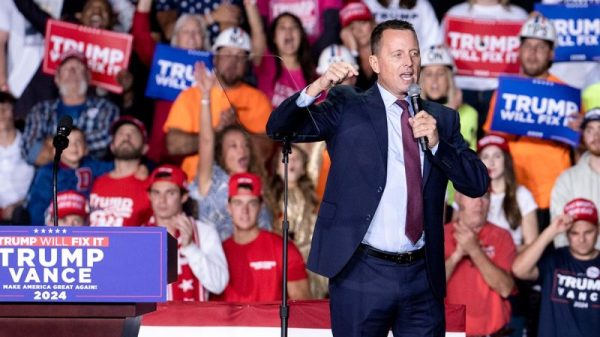Former president Donald Trump has long misled his audiences about the national debt. He frequently — and wrongly — asserts that tax cuts will generate more revenue and suggests he has an easy plan to begin paying down the debt. The national debt soared during his presidency, in part because of the pandemic, and as president he often flinched at making tough choices to rein in spending.
On Friday, in the space of two minutes with one of his favorite interviewers, Maria Bartiromo of Fox Business Network, Trump ran through a list of his incoherent claims. His assertions were prompted by a serious question posed by Bartiromo concerning Trump’s desire to eliminate all taxes paid by seniors on Social Security.
Currently, seniors above a certain annual income level ($25,000 for individuals and $32,000 for couples) pay taxes on a portion of their Social Security benefits. The revenue generated from these taxes is directed to the Social Security retirement trust fund, so Trump’s plan would bust a hole in the program’s finances.
Trump was sufficiently proud of his answers that he reposted on social media a section of the interview distributed by his campaign: “We are going to take care of Social Security. We not going to do anything to hurt our seniors. There is so much waste in this government. NO TAX ON SOCIAL SECURITY! NO TAX ON TIPS!” (Trump has also promised to eliminate taxes on tips.)
Here’s a line-by-line dissection of Trump’s comments. Anyone with a passing familiarity with the federal budget might find their brain hurts after reading them.
The Facts
Bartiromo began by noting that the nonpartisan Committee for a Responsible Federal Budget had estimated that eliminating all tax on Social Security benefits would mean increasing deficits by $1.6 trillion to $1.8 trillion over 10 years. These taxes also support Medicare. The group estimated that Trump’s policy would cause the Social Security Trust Fund to become insolvent in 2032, a year earlier than predicted now, while Medicare’s trust fund would become insolvent in 2030, six years earlier than predicted. At that point the programs could no longer pay full benefits.
Trump interrupted: “We can cut other costs. There’s so much waste in our government.”
Analysis: Be wary when a politician claims that money can be saved through “waste,” rather than eliminating a specific program that might have supporters. The numbers do not add up. Much of the federal government spending is on autopilot — mandated by federal law. Primarily this is spending for Social Security and Medicare — commitments the U.S. government made to seniors who have financed the programs during their working years. Only a relatively small part of the government is funded through discretionary spending, which is subject to congressional appropriations every year.
In fiscal year 2024, according to the nonpartisan Congressional Budget Office, discretionary spending is expected to be $1.8 trillion, and the total deficit is expected to be $1.9 trillion.
In other words, even if Trump eliminated all government spending approved by Congress — such as defense spending, welfare benefits, national parks and so forth — there would still be a budget deficit, even before he lost the revenue from taxes on Social Security benefits.
Bartiromo asked: “Where do you get the revenue to offset that? Because it’s also apparently going to advance the insolvency date of a Social Security retirement trust fund by over a year.”
Trump: “Well, you know, one of the things that’s good about that is that’s when people will make a deal, you know that. But we’re going to take care of Social Security. We’re not going to do anything to hurt our seniors.”
Analysis: Trump suggests he wants to generate a crisis to force a deal. But he offers no solution except for a vague promise that he won’t hurt seniors.
Policymakers have known for years that a long-term solution would likely require a combination of fixes. Democrats have favored raising payroll taxes or raising the income level (in 2024, $168,600) subject to tax. Republicans have preferred raising the retirement age from 67 or changing the rate at which benefits are adjusted for inflation. (President Barack Obama toyed with changing the inflation rate but backed off after being attacked by members of his own party.)
For Republicans, higher taxes are a non-starter. For Democrats, a higher retirement age is unfair to workers who earn money through manual labor. In 1983, when Ronald Reagan was president, the two parties came together on a Social Security deal that included both elements — but that was a much different era.
Trump: “There is so much cutting. There is so much waste in this government. There’s so much fat in this government.”
Analysis: Trump repeats his false claim that he could eliminate the deficit through cutting “waste.”
Trump: “I also have no tax on tips. That’s a big deal.”
Bartiromo: “Are you going to make that an official line item in your economic plans?”
Trump: “Yes. No tax on tips. No tax on tips. Very simple.”
Analysis: It’s not that simple. His proposal to eliminate taxes on tips has come under fire from the right-leaning Tax Foundation and the left-leaning Center for American Progress. Analysts say it would provide a minimal benefit to relatively few workers and could spur businesses to eliminate wage income in favor of tips.
Bartiromo pressed on: “What about the debt? I mean, you know, with no taxes on Social Security, no taxes on tips, I mean, when does 35 trillion in debt become an emergency?”
Trump: “You know, we were at a point, we were doing so well prior to covid, just prior to covid, we were going to start reducing debt and we’re going to start reducing taxes still further.”
Analysis: Trump ignores the question and offers a totally false claim. Until the federal government is running a budget surplus, the debt cannot be paid down. In January 2020, two months before covid devastated federal revenue and prompted emergency spending, CBO estimated a more than $1 trillion deficit in 2020 — and $13 trillion in deficits over the coming decade.
Even before covid, the deficit had worsened under Trump. But such rhetoric is in keeping with his effort to suggest the economy was booming before the pandemic — when in fact it was beginning to stumble. In all of 2019, manufacturing was in a mild recession, with some large manufacturers blaming Trump’s trade wars for slumping sales.
Trump: “You know, I gave the biggest tax cut ever, bigger than the Reagan tax cuts.”
Analysis: Trump slips in one of his favorite falsehoods. Trump’s tax cut amounted to nearly 0.9 percent of the gross domestic product, meaning it was far smaller than President Ronald Reagan’s tax cut in 1981, which was 2.89 percent of GDP.
Trump’s tax cut is the eighth-largest tax cut in the past century — and even smaller than two tax cuts passed under President Barack Obama. Trump’s tax cut was heavily tilted toward the wealthy and corporations.
Trump: “But you know what happened? It was very interesting. We took in more revenue with a smaller percentage of taxes than we did with the big percentage of taxes, and nobody understood it. I did, some people did, but few people understood it. But when we cut taxes, we took in much more money.”
Analysis: Trump doesn’t understand it. He once again betrays a fundamental misconception of the federal budget. Before the pandemic, government revenue under Trump was always supposed to go up year after year, despite the tax cut. That’s because the tax cut merely slowed the growth of revenue; it did not reduce it.
The Trump tax bill was estimated in 2017 to reduce taxes by $280 billion in 2019 and $259 billion in 2020. Those sound like big numbers, but even so, the tax revenue collected was also anticipated to keep going up, year after year, because the tax cut was too small to offset anticipated gains in revenue from inflation and anticipated economic growth. (See our video on federal budget “baselines” below.)
When the Congressional Budget Office produced its baseline budget projections a few months after the passage of the tax bill, it showed federal revenue would keep increasing, even after those tax cuts:
2017: $3.31 trillion
2018: $3.34 trillion
2019: $3.49 trillion
2020: $3.68 trillion
Still, since Trump signed bills that cut taxes and dramatically increased spending, before the pandemic, the deficit under Trump soared — from $665 billion in fiscal 2017 to more than $1 trillion in 2020.
Trump: “The country made more money and we were getting ready for growth. We were getting ready to pay off debt.”
Analysis: Trump repeats his falsehood that the country was about to pay off the debt when he was president.
A Trump campaign spokesman did not respond to a request for comment.
The Pinocchio Test
In just over two minutes, Trump managed to say four false claims:
He could easily replace the revenue lost from eliminating taxes on Social Security benefits by eliminating “waste.”
He was ready to pay down the national debt before the pandemic.
He passed the largest tax cut in U.S. history.
The 2017 tax cuts increased tax revenue.
With Trump, it’s never clear whether he is truly ignorant about these issues or if he assuming he can skate by because he thinks his audience is ignorant. But it’s clear he earned Four Pinocchios.
Four Pinocchios
(About our rating scale)
Send us facts to check by filling out this form
Sign up for The Fact Checker weekly newsletter
The Fact Checker is a verified signatory to the International Fact-Checking Network code of principles







































